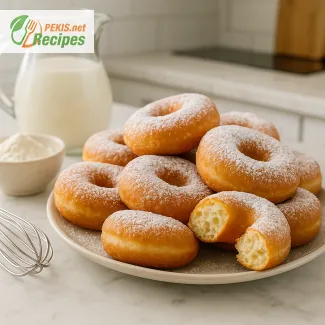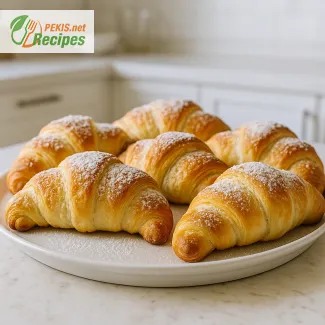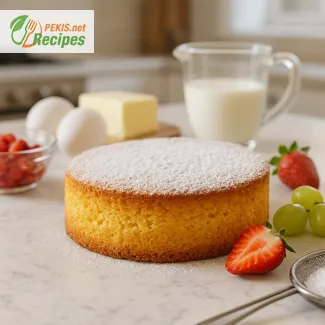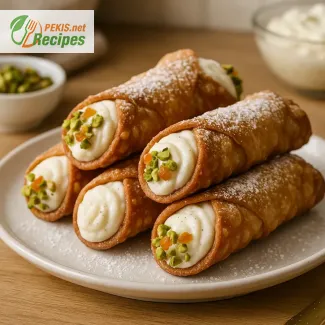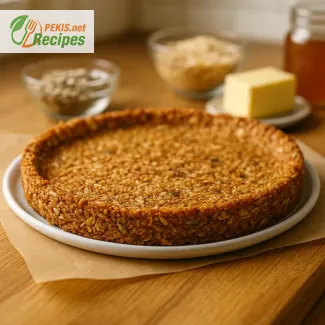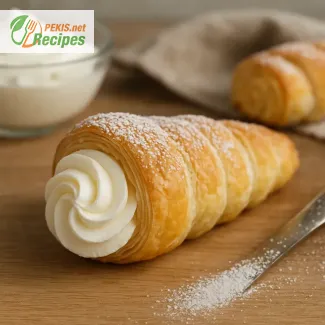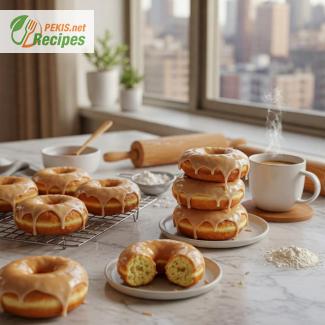
The Perfect Glazed Doughnuts – Soft, Fluffy, and Irresistible
A Timeless Treat for Every Occasion
There’s something truly magical about homemade glazed doughnuts—the warm, pillowy texture, the delicate sweetness, and that glossy, sugary coating that melts in your mouth. Whether you’re an experienced baker or a first-timer in the kitchen, nothing compares to the joy of biting into a freshly made doughnut straight from your own oven or fryer.
From morning coffee companions to indulgent afternoon snacks, glazed doughnuts are a universal favorite. Their light and airy dough, combined with a silky vanilla-infused glaze, creates a treat that’s impossible to resist. Unlike store-bought options, making them at home ensures a perfect balance of flavor, freshness, and texture—without unnecessary additives or preservatives.
The History Behind the Classic Doughnut
Doughnuts have been a beloved pastry for centuries, tracing their origins to early European settlers who brought fried dough recipes to America. Over time, this simple concept evolved into the iconic ring-shaped treat we know today. It was in the early 20th century that the glazed doughnut gained widespread popularity, thanks to advancements in commercial production. However, nothing beats the taste of a homemade doughnut, made with care and patience.
Whether you prefer a light vanilla glaze, a rich chocolate coating, or a sprinkle of cinnamon sugar, glazed doughnuts can be customized in countless ways. The secret to achieving that perfect texture lies in the dough—soft, slightly chewy, and full of buttery richness.
What Makes the Perfect Glazed Doughnut?
A truly great glazed doughnut isn’t just about the glaze—it’s about achieving the perfect balance of ingredients and technique. Here are the key elements that set the best doughnuts apart:
1. A Soft, Airy Dough
The foundation of any doughnut is its dough. A well-kneaded, yeast-leavened dough ensures a fluffy, cloud-like texture. Letting the dough rise properly gives the doughnuts their signature lightness.
2. A Golden, Crisp Exterior
Frying at the right temperature is essential to achieving that perfectly golden crust without making the doughnuts too oily. The result? A crisp bite that gives way to a soft, melt-in-your-mouth interior.
3. A Smooth and Shiny Glaze
The glaze is what sets these doughnuts apart. A classic combination of powdered sugar, milk, and vanilla creates a silky, glossy coating that clings to the doughnuts and adds a deliciously sweet finish.
The Joy of Making Doughnuts at Home
One of the best things about making glazed doughnuts at home is the ability to control every aspect of the recipe. You can experiment with different flavors, fillings, and toppings, creating a treat that’s tailored to your personal preferences. Want a hint of citrus? Add a touch of lemon zest to the glaze. Craving a richer taste? Swap vanilla extract for maple or almond.
The process of making homemade doughnuts is also incredibly rewarding. Watching the dough rise, shaping the rings, and seeing them puff up in the fryer is a baking experience like no other. Plus, the aroma of freshly fried dough and warm vanilla glaze filling your kitchen is absolutely irresistible.
Tips for the Best Homemade Doughnuts
To achieve the perfect glazed doughnut, follow these expert tips:
- Use fresh yeast for the best rise and fluffiest texture.
- Let the dough rise slowly, preferably overnight, to develop a deeper flavor.
- Maintain the right oil temperature (around 175-180°C / 350-360°F) to prevent greasy doughnuts.
- Glaze while warm so the doughnuts absorb just the right amount of sweetness.
- Experiment with toppings—try crushed nuts, sprinkles, or even a drizzle of caramel for extra indulgence.
A Treat for Every Occasion
Whether you're making them for a weekend brunch, a birthday party, or just a sweet craving, homemade glazed doughnuts are a guaranteed crowd-pleaser. Their soft, tender bite and rich, sugary glaze make them the ultimate comfort food. Once you master this classic recipe, you’ll never go back to store-bought doughnuts again.
So, grab your ingredients, heat up the fryer, and get ready to enjoy the most delicious homemade glazed doughnuts you've ever tasted!
- Activate the yeast: In a bowl, mix the warm milk, sugar, and yeast. Let it sit for 5–10 minutes until foamy.
- Make the dough: In a large bowl, whisk the eggs and melted butter, then add the yeast mixture, flour, salt, and vanilla extract. Knead the dough until smooth (about 8 minutes).
- Let it rise: Cover and let the dough rise in a warm place for 1–2 hours until doubled in size.
- Shape the doughnuts: Roll out the dough to about 1 cm (½ inch) thickness and cut out doughnut shapes using a round cutter. Let them rest for 30 minutes.
- Fry the doughnuts: Heat the oil to 175°C (350°F). Fry each doughnut for 1–2 minutes per side until golden brown. Drain on paper towels.
- Prepare the glaze: Whisk together the powdered sugar, milk, and vanilla extract until smooth.
- Glaze the doughnuts: Dip each warm doughnut into the glaze and let it set on a wire rack.
Elevating the Classic Glazed Doughnut – Tips for a Perfect Recipe
Small Changes That Make a Big Difference
Making homemade glazed doughnuts is already a rewarding experience, but with a few adjustments, you can take them to a whole new level. From tweaking ingredients to refining your cooking technique, small improvements can result in lighter, fluffier, and even more flavorful doughnuts. Whether you’re looking for a richer taste, a healthier alternative, or a foolproof method to avoid common mistakes, these expert tips will help you perfect this classic treat.
The Impact of Ingredients on Texture and Flavor
Every ingredient in a doughnut recipe plays a vital role in determining texture, taste, and consistency. Modifying these elements slightly can yield noticeable improvements.
Choosing the Right Flour
Traditional all-purpose flour works well for this recipe, but if you want a more delicate and airy texture, consider using bread flour. Bread flour has a higher protein content, which helps create a better gluten structure, leading to lighter and chewier doughnuts.
If you prefer a more tender and soft doughnut, replace a portion of the flour with cake flour. This lowers the gluten content and results in a more delicate bite. A good balance is 75% all-purpose flour and 25% cake flour.
Enhancing Flavor with Butter and Milk
Butter adds richness to the dough, but browning the butter before incorporating it into the mixture brings out a nutty, caramel-like depth that enhances the overall taste. Similarly, replacing regular milk with buttermilk makes the doughnuts slightly tangy and helps keep them extra moist.
The Power of Vanilla and Spices
While vanilla extract is a key component of a classic glaze, upgrading to pure vanilla bean paste provides a stronger, more fragrant vanilla flavor. For added warmth, try incorporating a pinch of cinnamon, nutmeg, or cardamom into the dough. These spices subtly enhance the flavor without overpowering the glaze.
The Importance of Proper Dough Preparation
Even with the right ingredients, how you handle the dough makes a huge difference in the final outcome.
Kneading and Proofing the Dough
Over-kneading can lead to tough doughnuts, while under-kneading may cause them to be too dense. The key is to knead until the dough becomes smooth and elastic, which usually takes about 8 minutes by hand or 5 minutes using a stand mixer.
The first proofing should be slow and steady. Letting the dough rise in the refrigerator overnight (instead of at room temperature) helps develop a more complex flavor and improves the dough’s structure.
Shaping Doughnuts Perfectly
For evenly shaped doughnuts, always use a sharp round cutter and avoid twisting it while cutting. Twisting seals the edges and prevents the dough from expanding properly, resulting in uneven frying.
Mastering the Frying Technique
One of the biggest challenges in making homemade doughnuts is frying them correctly. Even slight temperature variations can make a difference.
Maintaining the Right Oil Temperature
If the oil is too hot, the outside will brown too quickly while the inside remains raw. If the oil is too cool, the doughnuts will absorb excess oil and become greasy. The optimal frying temperature is 175-180°C (350-360°F). Using a kitchen thermometer ensures consistency.
Flipping and Draining
Doughnuts should be fried for about 1-2 minutes per side. To prevent oil absorption, place them on a wire rack instead of paper towels after frying, which allows excess oil to drain properly without making them soggy.
Perfecting the Glaze
A smooth and shiny glaze is what makes glazed doughnuts irresistible. To achieve the perfect consistency, follow these steps:
- Sift the powdered sugar before mixing to avoid lumps.
- Use warm milk instead of cold to help dissolve the sugar evenly.
- Dip the doughnuts while they are still warm, allowing the glaze to form a thin, glossy coating.
For variations, experiment with flavored glazes like chocolate, maple, or coffee by adding cocoa powder, maple syrup, or espresso powder to the mixture.
Common Mistakes and How to Avoid Them
Even experienced bakers can run into challenges. Here are some of the most frequent mistakes and how to fix them:
- Dense Doughnuts: This often happens due to underproofing or using too much flour. Allow the dough to rise fully and measure flour correctly by spooning it into the cup instead of scooping.
- Oily Doughnuts: This results from frying at too low a temperature. Always keep the oil at 175-180°C (350-360°F).
- Uneven Browning: This may be due to overcrowding in the fryer. Fry in small batches for even cooking.
- Glaze Absorption: If the doughnuts absorb too much glaze, let them cool slightly before dipping.
Healthier Alternatives Without Compromising Taste
For those who want a lighter version of glazed doughnuts, there are several modifications that still maintain great taste and texture.
Baking Instead of Frying
While frying gives doughnuts their classic crispness, baking them at 190°C (375°F) for 10-12 minutes offers a lower-fat alternative. Brushing them with a little melted butter after baking enhances their richness.
Using Whole Wheat or Almond Flour
Replacing half of the all-purpose flour with whole wheat flour adds fiber and nutrients while keeping the doughnuts fluffy. Alternatively, almond flour brings a slightly nutty flavor while reducing carbohydrates.
Reducing Sugar
Instead of using refined sugar in the dough, consider using honey or maple syrup, which add a more complex sweetness. The glaze can also be modified by using Greek yogurt and honey instead of powdered sugar and milk.
Why Homemade Doughnuts Are the Best Choice
There’s a significant difference between store-bought doughnuts and homemade ones. Making them yourself allows for ingredient control, avoiding unnecessary preservatives and artificial flavors.
Additionally, homemade doughnuts can be customized to suit individual preferences—whether it’s adjusting sweetness, experimenting with fillings, or creating unique toppings. Plus, the satisfaction of making doughnuts from scratch makes the experience even more enjoyable.
By making small adjustments to ingredients, technique, and preparation, you can transform a traditional glazed doughnut recipe into something truly exceptional. Whether you choose to enhance flavors, master the perfect frying technique, or create a healthier alternative, each change contributes to an even better version of this beloved treat.
Next time you make homemade glazed doughnuts, try incorporating these tips and experience the difference in texture, taste, and overall quality.
- Contains: gluten (flour), dairy (milk, butter), eggs.
- Gluten-free alternative: Substitute all-purpose flour with a gluten-free baking mix.
- Dairy-free alternative: Use plant-based milk and vegan butter.
- Egg-free alternative: Replace eggs with 60 g (¼ cup) applesauce or mashed banana.
- Calcium: 30 mg – Supports strong bones and teeth.
- Iron: 1.5 mg – Essential for oxygen transport in the blood.
- Potassium: 80 mg – Helps regulate muscle function and fluid balance.
- Magnesium: 10 mg – Supports nerve function and energy production.
- Vitamin E (in vegetable oil): Protects cells from oxidative stress.
- Flavonoids (from vanilla extract): May help reduce inflammation.
- Polyphenols (from flour): Support heart health.
